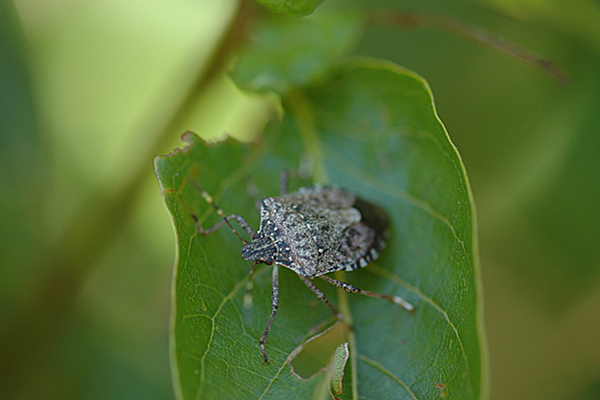
Stink bug season
Fall means pumpkins on vine, stink bugs in house
2:10 p.m., Oct. 3, 2011--Pull up the welcome mat; they're back. It's early fall in Delaware, which means pumpkins on the vine, apples on the trees and stink bugs in the house.
"Last year, I got a flood of calls about stink bugs during the last week of September," said Brian Kunkel, an entomologist with the University of Delaware's Cooperative Extension. "Sure enough, this past week, Extension has been hearing from homeowners trying to get rid of stink bugs."
Campus Stories
From graduates, faculty
Doctoral hooding
"As the days grow shorter and the evening temperatures cooler, Delawareans are discovering these uninvited houseguests in their garages, porches and decks, as well as inside the house," Kunkel said. "The brown marmorated stink bug becomes a nuisance pest when it heads inside to find overwintering sites."
While merely an annoyance to most homeowners, the brown marmorated stink bug (BMSB) poses an economic threat to Delaware agriculture. Fruit crops seem to be at greatest risk, especially peaches and apples. About 18 percent of the mid-Atlantic apple crop had stink bug damage last year, according to the U.S. Apple Association.
"West Virginia apple orchards experienced significant crop loss last season because of the BMSB," Kunkel said. "Here at UD, we're doing everything we can to make sure that we don't see the kind of crop loss that West Virginia had."
Several of Kunkel's colleagues in Extension and UD's College of Agriculture and Nature Resources are researching BSMBs in soybean, lima bean, sweet corn, field corn and sweet pepper fields.
Two of the most active researchers are Joanne Whalen, the Extension's integrated pest management specialist, and Bill Cissel, an Extension associate who is investigating stink bugs as part of his graduate studies.
Cissel and Whalen, assisted by two interns, are examining stink bugs in conditions similar to home yards and gardens, too. In UD's Garden for the Community, a one-third-acre plot on the Newark campus, the duo surveyed stink bug nymphs, adults and egg masses on plants commonly grown in home gardens -- tomatoes, zucchini, yellow squash, cucumbers, eggplant, sunflowers and bell peppers. Plus, they're studying a plot of ornamental plants to see which plants stink bugs use as hosts.
Rutgers University, Virginia Tech, the University of Maryland and the Delaware Soybean Board are some of the partners on one or more of these projects.
Although Delaware has several native stink bugs, BMSBs originates in Asia and were accidentally introduced to the United States. First collected in Allentown, Pa., in 1998, BMSBs have been spreading across the eastern half of the U.S. ever since.
Kunkel said spiders and birds have been known to eat BMSBs (he's heard reports of house cats eating them, too) but the pest has no recognized natural predator here.
The USDA Beneficial Insects Introduction Research Lab, housed on UD's campus, is investigating biocontrol measures. Biocontrol introduces natural predators into an environment to control, if not eradicate, the pest problem. But the rigorous research process and government approvals needed for biocontrol measures can take years, even decades.
Delaware's farmers are asking for help now. So the focus of Whalen and Cissel's research is on monitoring to determine when to control stink bugs, as well as which insecticides provide the best control.
Field observations in 2010 indicated that stink bug infestations usually start on the perimeters of fields, Cissel noted. "We're studying whether perimeter applications of insecticides will prevent stink bugs from penetrating the interior parts of soybean fields," he said.
"In our corn research, we are trying to determine how much damage stink bugs are causing and when the plant is most sensitive to damage -- is it when it's silking, during grain fill or closer to harvest?"
Insect research projects typically run for two to three seasons, and most of the UD studies are in their first year. So it's too early to discuss preliminary results, Cissel said, especially since the BMSBs weren't as active this summer as previously.
"We had a really large outbreak last year," Kunkel said, "but we're not seeing those kinds of numbers this year."
Tell that to Kathy Fichter, a resident of Chadds Ford, Pa.
"It's just as bad as last year and it's only the beginning of stink bug season here," said Fichter, who always has a tissue at hand, ready to scoop up stink bugs. "My two sons won't go near them, and these are boys who like bugs," she said.
"Our neighborhood seems to be a 'vacation destination' for stink bugs. They come here by the hundreds, maybe even thousands," she added. "My neighbors are in the same predicament. Yet, a few miles away, they aren't such a nuisance."
Kunkel isn't surprised by Fichter's stink bug woes, even though regional conditions are generally better. "Stink bug outbreaks -- and insect outbreaks in general -- tend to be localized," he said. "We often hear of one neighborhood getting slammed while another neighborhood a half-mile away will have very few bugs."
If the BMSB already has arrived at your house -- or you want to make sure it doesn't -- take control measures now. The best thing you can do, Kunkel said, is to seal all cracks around windows, doors, siding, utility pipes and chimneys. Often overlooked, he said, are the cracks that can appear around dryer vents and gaps around window air-conditioning units.
"Try to look on the bright side," Kunkel said. "Stink bugs that get inside are helping you to winterize your house. Wherever they got in today is where the cold winter winds will, later this year."
Article by Margo McDonough








